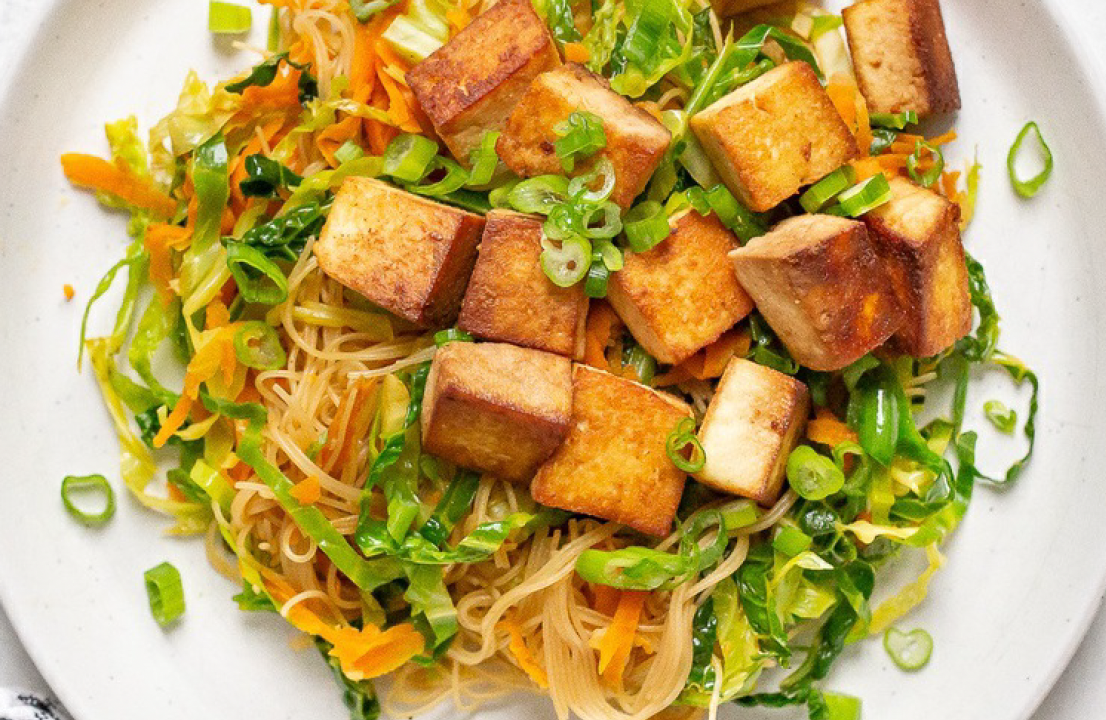
Coconut-crusted haddock
Haddock is currently in season, and this makes a great Friday night fish recipe. Pair along with a variety of green veggies, some roast sweet potato, and you have a filling and easy meal.
Ingredients (serves 1):
- 2 tbsp unsweetened shredded coconut
- 1 tbsp olive oil
- 1 garlic clove, crushed
- Seasoning to taste
- 1 haddock fillet
- 1 tsp finely chopped parsley
- 1/4 lemon
Method
- Preheat oven to 200 degrees celsius. Line a baking sheet with parchment paper.
- Combine the coconut, garlic and olive oil. Season to taste.
- Place the haddock on the baking sheet and gently scoop the coconut mixture on top of the haddock, pressing it down gently.
- Cook in the oven for 10 minutes.
- Add the parsley and a squeeze of lemon. Serve with veggies
- Enjoy!

Savoy cabbages are one of my *favourite* vegetables. If you are just used to having them boiled or steamed, think again! They are delicious when stir-fried.
As many people are trying Veganuary or at least some meat-free days, this might be one to try this month. Particularly, as Savoy cabbages are now in season!
Serves 4
Ingredients:
2 tbsp avocado oil (divided)
340g tofu (extra firm, pressed and cubed)
3 tbsp tamari
3 garlic cloves, crushed
2 spring onions, sliced
1 savoy cabbage, shredded
1 medium carrot, sliced into batons
240 ml vegan broth
113g rice vermicelli noodles (dry, uncooked)
Method:

Is histamine intolerance causing your symptoms?
What you eat and your health are a fantastically complicated puzzle. For so many reasons linked to modern living, some foods can disagree with you. You may already experience this directly. People with digestive problems can often point to specific foods causing upsets and, if you think you have a food intolerance, you might already suspect wheat, dairy, yeast, eggs, or any number of foods to be the culprit lurking behind your symptoms.
There’s one often-overlooked component found in some foods that you might not know about yet that I want to talk about today. Could it be this that’s causing you problems?
Histamine…too much of it for your body
If you have an allergy, you might already know about histamine since you probably take antihistamines to try to neutralise the effect is has on the body. Histamine is a signalling molecule that has a lot of roles in the body like making stomach acid and keeping you alert. It is also involved in the immune response and protects you from foreign invaders.
When your immune system spots a potential invader, one type of immune cell (your B cells) to make IgE antibodies and these are a bit like warning signals to other immune cells to tell them to be on alert. When they meet the ‘invader’, other immune cells (this time your mast cells and basophils) throw out histamine and other inflammatory chemicals to neutralise the attack.
This works really well for some types of invader - like parasites, as an example – but not so much when the system overreacts to harmless substances like peanuts, pollen, animal hair. Welcome to the common allergy. It’s a histamine thing. And, if you have an allergy, you might be well used to antihistamines that can block or dampen the effect of this kind of allergic response.
If you’re reading this thinking, this doesn’t concern me as I don’t have an allergy, here’s why you should be interested. Histamine can be a problem for many other people – especially women since there is a big link between oestrogen and the cells that release histamine.
Histamine symptoms tend to track with your menstrual cycle, peaking when oestrogen is at its highest and then again before your period. If you experience any of these symptoms, histamine could be the culprit:
This is because oestrogen stimulates the mast cells to make histamine while at the same time downregulating an enzyme called that breaks down histamine, diamine oxidase (DAO). As a triple whammy, histamine triggers the ovaries to make more oestrogen. This can result in oestrogen dominance, where oestrogen is present in the wrong ratio to other hormones.
Histamine problems can also be a feature of perimenopause due to erratic release of oestrogen. Although oestrogen levels are dropping rapidly, progesterone falls faster, leaving oestrogen unopposed.
Why do some people suffer, and others don’t?
Dealing with histamine problems
One of the things you can do to manage histamine problems is reducing foods that either contain histamine or are ‘histamine liberators’.
Which foods contain histamine?
These foods, while they don’t contain histamine, trigger the release of histamine:
And alcohol and black or green tea interfere with the enzymes needed to break down histamine.
Improving your gut health is always worth doing since do much of your health relies on a healthy gut. If you’ve been ignoring symptoms, especially if you think you have irritable bowel syndrome (IBS), we should talk. Getting your digestive system back into balance pays dividends for all aspects of your health.
Inflammatory foods like gluten, dairy, sugar and processed foods make the situation worse, encouraging the body to release inflammatory cytokines and histamine.
At the same time, increase anti-inflammatory foods. An easy way to do this is to add herbs and spices into your cooking. Particularly helpful ingredients include ginger, thyme, oregano, basil, chamomile, and turmeric
Support oestrogen detoxification by eating plenty of cruciferous veggies like broccoli, cauliflower, cabbage, Brussels sprouts
If you experience any of the symptoms I’ve talked about here, please do get it touch. It’s very easy to read things like this or take advice from Dr Google and end up following a very restrictive diet when this is not always necessary. Working one-to-one with a nutrition professional means that you can take advantage of their years of study to find a programme that helps support your health without overly restricting what you eat. It’s a minefield out there!

Sugar-Free White Christmas Bites
These are delicious little Christmas bites which make a great treat to have during the festive season.
And they look beautiful too!
Makes 20
Ingredients:
562 ml coconut butter
281 ml coconut milk
1 vanilla pod, seeds scraped
1 tbsp rice malt syrup
50g desiccated coconut
100g macadamia nuts, chopped
100g pistachios
100g frozen raspberries (keep in freezer until ready to use)
Method:

6 expert ways to beat stress at Christmas and feel calm TODAY
It’s meant to be ‘the most wonderful time of the year’ but the pressure of the holidays can often mean a stress overload.
Here’s what to do about it.
Though you look forward to it all year, when Christmas arrives the experience can be pretty overwhelming. Trying to get everything ready in time can be incredibly stressful, especially for women – a third of whom feel more stressed in December than any other month, according to research.
And small wonder. Money worries, family tensions, pressure to socialise, and over-excited children on a sugar high is hardly a recipe for success. And, if you struggle to stay at your happy weight or often turn to food as a way of coping or rewarding yourself, being surrounded by treats and snacks over the holidays rarely has a happy ending.
Managing stress levels is important for your health in the long term because stress is implicated in so many different chronic diseases, including heart disease, Alzheimer’s, diabetes, depression, gastrointestinal problems and asthma.
If you’re thinking you don’t fall into the ‘I’m stressed enough to be making myself ill’ category, don’t be fooled. The drip-drip-drip of everyday stress can be as damaging as major life incident-related stress (such as death and divorce), so don’t wait to take action.
It’s also worth considering that stress makes it very hard to lose weight, and you’re much more likely to store it around the middle. This is because the human body hasn’t evolved much since caveman times, when the extra energy was stored where it was most easily accessed, so it could be used to run away from the sabre-toothed tiger.
Here are my top 6 ways to keep stress under control in the run up to the holidays:

Increase your antioxidants
Want to bulletproof your immunity? You need to stockpile those natural antioxidants (and not just the packets and tins of pulses!). When you supercharge this “antioxidant potential” you give your immune system a real boost.
And, if you’re wondering ‘where have I heard about antioxidants before?’ they’re the things skincare companies tell you their anti-ageing moisturisers are full of so double win.
Why are antioxidants important?
Viruses and bacteria produce oxidants, which are reactive forms of oxygen that damage cells and age you faster. Simply, they are bad news. We’re also getting our fill of oxidants from eating chargrilled/ blackened foods or breathing polluted air, and maybe you’ve had a less than great diet over the years. Where you can end up is a situation in which you have too many oxidants and not enough antioxidants.
Revving up your antioxidant status at times like these is a really good idea. While vitamin C seems to get all the praise when it comes to immunity, there’s another molecule that is the under-recognised supporting actor who deserves the starring role – glutathione.
Glutathione – the master antioxidant
Glutathione is one of the most important molecules in the body – almost like a magic elixir of health. Too little of it and you’re at risk of developing one of the most feared health conditions facing us today, including stroke, Alzheimer’s disease, and heart disease.
If you’ve got good enough levels, that’s where the gold is…
But when levels are adequate or high, that’s when the magic happens. You’ll not only have protection from the conditions above, but you’ll have amazing energy, glowing skin, healthy detoxification, strong heart and brain function, and possibly even a longer life!
Glutathione is made up of three amino acids called cysteine, glycine, and glutamic acid (or glutamate). It’s often called the “master” antioxidant because it helps recycle all the other antioxidants in your body like vitamins C and E, as well as alpha lipoic acid and CoQ10.
Research show glutathione primes the white blood cells of the immune system and helps them produce more infection-fighting substances so they can control both bacterial and viral infections.
Foods to increase glutathione
Eating the right foods to naturally increase glutathione will help keep you fighting fit. There are a small number of foods that naturally contain glutathione. These include asparagus, avocado, cabbage, Brussels sprouts, spinach, broccoli, garlic, chives, tomatoes, cucumber, almonds, and walnuts.
Some other foods contain the building blocks needed to make glutathione (they are the pre-cursors – the warm-up act); the foods containing cysteine and other sulphur-containing foods, and selenium.
Good foods to choose are onions, spring onions, shallots, leeks, kale, bok choy, rocket, spring greens, watercress, radishes. Some spices such as turmeric, cinnamon and cardamom - have compounds that can also help to restore healthy levels of glutathione and its antioxidant enzymes.
Alpha Lipoic Acid – glutathione’s reloader
Alpha lipoic acid (also called ALA) is a critical co-enzyme that helps to recycle many antioxidants, including vitamin C, E and also glutathione. It is well known for its anti-ageing effects on our cell’s energy factories, the mitochondria.
Good food sources of alpha lipoic acid include:
• Organ meats
• Beef
• Brewer’s yeast
• Broccoli
• Spinach
• Brussels sprouts
• Peas
• Tomatoes
Selenium is an important trace mineral that is key in the production of glutathione (it also happens to be great for thyroid function so if yours is a little off, consider getting more of this antioxidant a double win). Good dietary sources of selenium include:
• Seafood
• Oysters
• Brazil nuts
• Eggs
• Mushrooms
• Whole grains
• Organ meats
• Dairy products
So rather than reaching for an immune supplement, why not think about how you can increase these immune-supporting foods in your diet?
Or, if you're struggling for inspiration, why don’t you book in a free 30-minute health review with me – just click here.
![]()
Please get in touch and find out more - I offer a free 30-minute exploratory call.